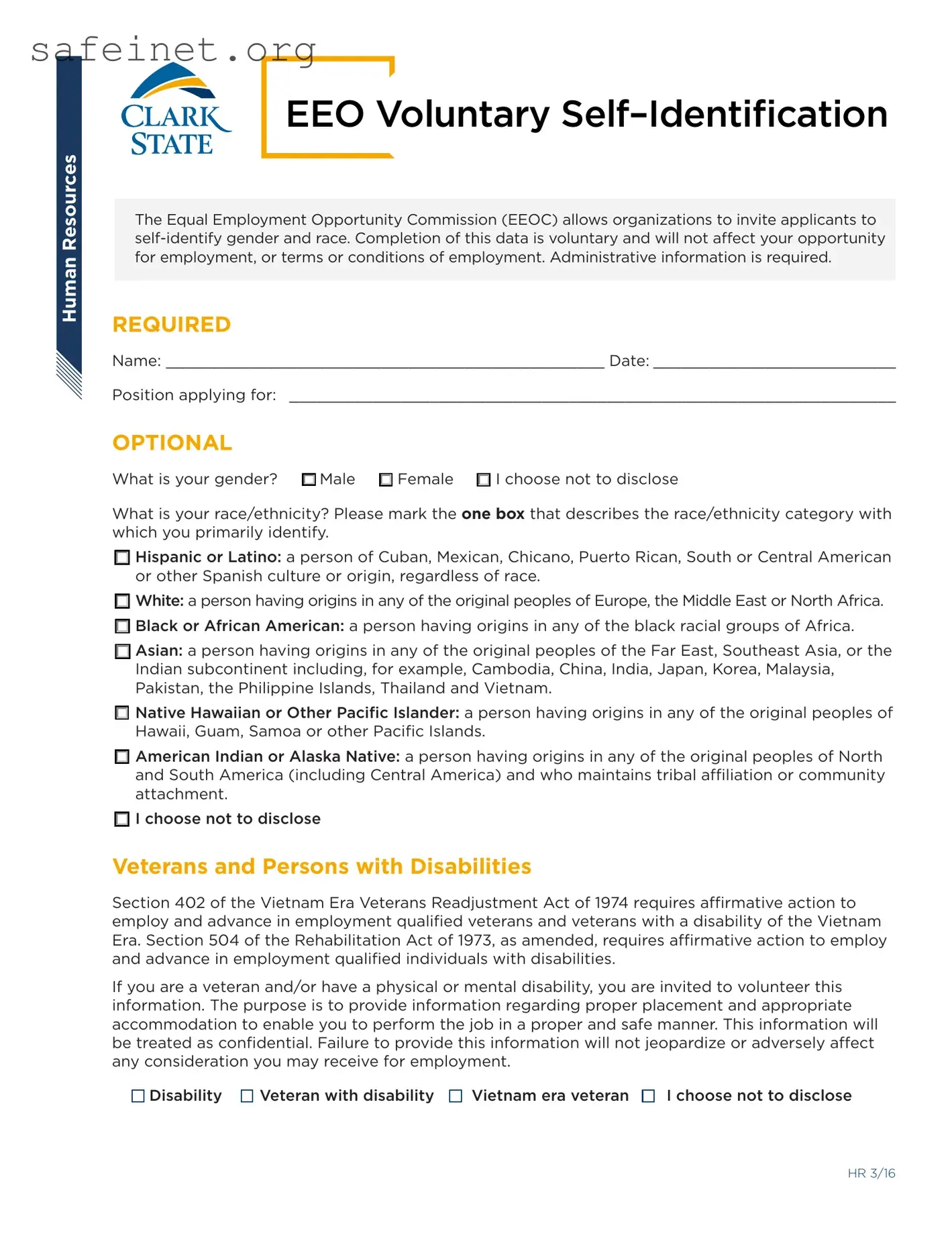EEO Voluntary Self–Identification
The Equal Employment Opportunity Commission (EEOC) allows organizations to invite applicants to self-identify gender and race. Completion of this data is voluntary and will not affect your opportunity for employment, or terms or conditions of employment. Administrative information is required.
REQUIRED
Name: _______________________________________________ Date:___________________________
Position applying for: _ _________________________________________________________________
OPTIONAL
What is your gender? |
Male |
Female |
I choose not to disclose |
What is your race/ethnicity? Please mark the one box that describes the race/ethnicity category with which you primarily identify.

 Hispanic or Latino: a person of Cuban, Mexican, Chicano, Puerto Rican, South or Central American or other Spanish culture or origin, regardless of race.
Hispanic or Latino: a person of Cuban, Mexican, Chicano, Puerto Rican, South or Central American or other Spanish culture or origin, regardless of race.

 White: a person having origins in any of the original peoples of Europe, the Middle East or North Africa.
White: a person having origins in any of the original peoples of Europe, the Middle East or North Africa.

 Black or African American: a person having origins in any of the black racial groups of Africa.
Black or African American: a person having origins in any of the black racial groups of Africa.

 Asian: a person having origins in any of the original peoples of the Far East, Southeast Asia, or the Indian subcontinent including, for example, Cambodia, China, India, Japan, Korea, Malaysia, Pakistan, the Philippine Islands, Thailand and Vietnam.
Asian: a person having origins in any of the original peoples of the Far East, Southeast Asia, or the Indian subcontinent including, for example, Cambodia, China, India, Japan, Korea, Malaysia, Pakistan, the Philippine Islands, Thailand and Vietnam.

 Native Hawaiian or Other Pacific Islander: a person having origins in any of the original peoples of Hawaii, Guam, Samoa or other Pacific Islands.
Native Hawaiian or Other Pacific Islander: a person having origins in any of the original peoples of Hawaii, Guam, Samoa or other Pacific Islands.

 American Indian or Alaska Native: a person having origins in any of the original peoples of North and South America (including Central America) and who maintains tribal affiliation or community attachment.
American Indian or Alaska Native: a person having origins in any of the original peoples of North and South America (including Central America) and who maintains tribal affiliation or community attachment.

 I choose not to disclose
I choose not to disclose
Veterans and Persons with Disabilities
Section 402 of the Vietnam Era Veterans Readjustment Act of 1974 requires affirmative action to employ and advance in employment qualified veterans and veterans with a disability of the Vietnam Era. Section 504 of the Rehabilitation Act of 1973, as amended, requires affirmative action to employ and advance in employment qualified individuals with disabilities.
If you are a veteran and/or have a physical or mental disability, you are invited to volunteer this information. The purpose is to provide information regarding proper placement and appropriate accommodation to enable you to perform the job in a proper and safe manner. This information will be treated as confidential. Failure to provide this information will not jeopardize or adversely affect any consideration you may receive for employment.
Disability |
Veteran with disability |
Vietnam era veteran |
I choose not to disclose |
HR 3/16



 Hispanic or Latino: a person of Cuban, Mexican, Chicano, Puerto Rican, South or Central American or other Spanish culture or origin, regardless of race.
Hispanic or Latino: a person of Cuban, Mexican, Chicano, Puerto Rican, South or Central American or other Spanish culture or origin, regardless of race.
 White: a person having origins in any of the original peoples of Europe, the Middle East or North Africa.
White: a person having origins in any of the original peoples of Europe, the Middle East or North Africa.
 Black or African American: a person having origins in any of the black racial groups of Africa.
Black or African American: a person having origins in any of the black racial groups of Africa.
 Asian: a person having origins in any of the original peoples of the Far East, Southeast Asia, or the Indian subcontinent including, for example, Cambodia, China, India, Japan, Korea, Malaysia, Pakistan, the Philippine Islands, Thailand and Vietnam.
Asian: a person having origins in any of the original peoples of the Far East, Southeast Asia, or the Indian subcontinent including, for example, Cambodia, China, India, Japan, Korea, Malaysia, Pakistan, the Philippine Islands, Thailand and Vietnam.
 Native Hawaiian or Other Pacific Islander: a person having origins in any of the original peoples of Hawaii, Guam, Samoa or other Pacific Islands.
Native Hawaiian or Other Pacific Islander: a person having origins in any of the original peoples of Hawaii, Guam, Samoa or other Pacific Islands.
 American Indian or Alaska Native: a person having origins in any of the original peoples of North and South America (including Central America) and who maintains tribal affiliation or community attachment.
American Indian or Alaska Native: a person having origins in any of the original peoples of North and South America (including Central America) and who maintains tribal affiliation or community attachment.
 I choose not to disclose
I choose not to disclose